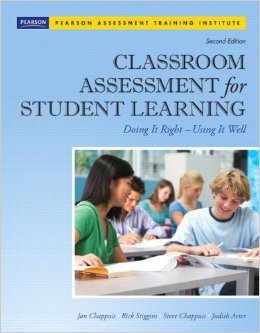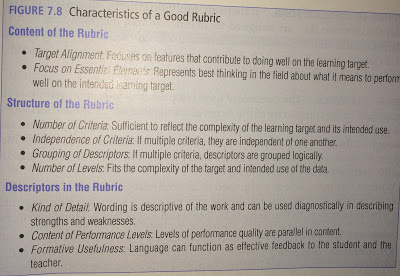Classroom Assessment Chapter 7

To help us work towards our school goal of improving our understanding and practice of assessment, my principal has provided our staff with a copy of Classroom Assessment for Student Learning: Doing it Right – Using it Well, by Jan Chappuis, Rick Stiggins, Steve Chappuis, and Judith Arter. As I make my way through the book, I will be summarizing my learning as a means of organizing my thoughts and getting clarification on particular ideas.
 |
| Classroom Assessment for Student Learning Cover. (Accessed 2016). Uploaded to Amazon; Pearson Education. Available online at: https://www.amazon.ca/Classroom-Assessment-Student-Learning-Doing/dp/0132685884 |
Chapter 7 – Performance Assessment
* see Chapter 4 for the most appropriate times to use selected response assessments
* before you begin, use the assessment development cycle and make a blueprint (Ch. 4)
* remember to not confuse activities with learning targets!
Determine Sample Size with Performance Assessment
1 ) Complexity of the Target
– the more complex, the more evidence required
(ex) reading rate = less complex, reading fluency = more complex
2 ) Decision the Evidence will Inform
– for learning requires low level of evidence
3 ) Consistency of Performance
– use professional judgement
– gather more evidence for students with high fluctuations
– make sure any applicable biases are addressed first
4 ) Proximity to the Cutoff Mark
– gather more evidence for those students who fall close to grade-divides
(ex) students who are between a 3-4 on the provincial report cards
Selecting, Revising, or Developing the Task
1 ) The Content
– what learning target is demonstrated?
2 ) Target Alignment
– content validity
– only assess aspects of the learning target; NOT things like neatness
3 ) Authenticity
– realistic context as close to real-life as practical
4 ) Choice
– use cautiously as choices need to fit the target, not vary in difficulty & ensure validity
5 ) Level of Scaffolding
– point the way to success without doing the thinking for the students
6 ) Interference
– make sure aspects of the task do not interfere with achieving the actual learning target
(ex) too high of reading level in the instructions, situations requiring specific cultural/linguistic backgrounds
Structure of the Task
– be as specific as possible and ensure students know:
– what knowledge they need (the target)
– what they need to accomplish
– what they are creating
– what materials they need
– how much time they have
– what conditions need to be met
– what help is allowed
– what scoring criteria will be used
 |
| Chappius, et al. (2012). Figure 7.8 Characteristics of a Good Rubric. Classroom Assessment for Student Learning, pg 231. |
* make sure scoring rubrics only include info on the qualities of the task; NOT directional instructions like word limits
Process for Developing Rubrics
1 ) Establish a Knowledge Base
– work with those knowledgeable in the area
– determine what quality looks like
– review existing rubrics for inspiration
2 ) Gather Samples of Student Performances/Rubrics
– familiarize yourself with a range of quality
– student work, provincial examples, peer examples, self created, hard copy, video, audio
– at least 20 pieces
3 ) Sort Work by Level of Quality
– sort into weak, medium & strong
– write specific descriptions as to why its sorted that way
– relate descriptions back to learning target
4 ) Cluster Descriptions by Trait
– combine similar descriptions
– omit repeats
– separate those that cannot be linked
5 ) Identify Samples that Illustrate Each Level
– will be used as models/examples
– which are strong? weak? start with the extremes
– have multiple examples for each level
– try to include those that identify common misconceptions
6 ) Test & Revise as Needed
_____________________________________________
I WANT TO KNOW:
I found this chapter very confusing as it seemed to focus more on rubrics (in general) than anything else….
Please leave your thoughts below 🙂